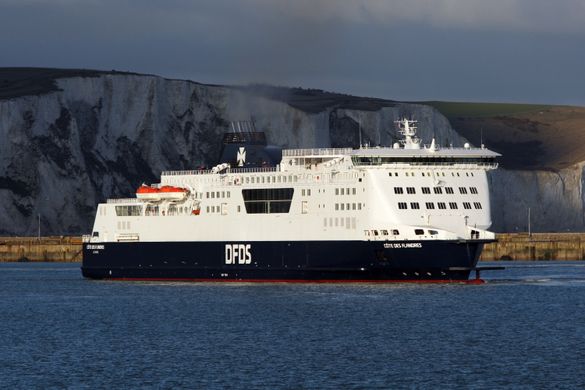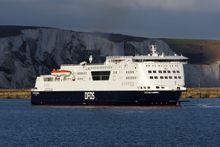 20 Apr 2023
20 Apr 2023
Since William the Conqueror won the Battle of Hastings in 1066 Britain and France, to paraphrase George Bernard Shaw, have been two countries divided by a common history. The two countries have been so intertwined for centuries and have swung from friends to enemies so often that the rivalry still endures today, though perhaps on a friendlier basis.
King Charles III's coronation on the 6th May is an historic event, and the first that we have seen for 70 years. It is thanks to the French that we have the monarchy we have today, and since 1066 it has had its fair share of history with France. With the coronation less than a month away, DFDS invites you to cross the Channel and find out more about some of the royal connections that link Britain and France.
William the Conqueror (1066 – 1087)
Caen was the city of William the Conqueror, and it is in large part his influence that made it such an important and prosperous medieval city. The legacy he left remains to this day, as evidenced by the city's two magnificent abbeys, the Abbaye-aux-Hommes and the Abbaye-aux-Dames, and a castle fit for a conqueror. William was interred at the Abbaye-aux-Hommes, which later fell victim to several acts of ransacking and desecration, and now all that remains of William's body is a thigh bone. In the 19th century a marble slab was laid on the floor of the abbey to replace the original tomb, and the thigh bone was reburied beneath. Visitors are welcome to explore the abbey themselves or with a guide, who will be able to share information about the history and architecture of the abbey. There are also exhibits about life in Normandy during the medieval period and Caen's role in World War II and D-Day.
The impressive Chateau de Caen was built by William in 1060. This large, imposing castle still retains its outer walls, and the ramparts offer spectacular views across Caen. The castle has recently undergone extensive restoration work and archaeological excavations are still ongoing. Visitors can see the collection of relics and discoveries that have already been found at the castle. It is open to tourists and contains two museums - the Museum of Normandy and the Museum of Fine Arts.
Richard the Lionheart (1189 – 1199)
During the Hundred Years War, Rouen became the scene of many confrontations between the English and the French, including the Siege of Rouen by Henry V and the trial and execution of Joan of Arc by the English army, but one of England's most famous and renowned kings is also buried there (partly).
Despite being born here, Richard the Lionheart probably spent less than six months in England and likely didn't even speak the language. He spent much of his time in the Holy Land fighting in the Crusades, where his bravery and military prowess earned him the name 'Lionheart'.
When Richard died, his body was split up and buried in different locations. His torso was buried in Fontevraud Abbey near Angers, and his embalmed heart was sent to Rouen Cathedral. Visitors can see the sarcophagus and effigy of Richard the Lionheart in the cathedral, and the powdered remains of his heart are inside.
Henry V (1413 – 1422)
The Hundred Years War was fought between 1337 and 1453 between the English House of Plantagenet and the French House of Valois for claim over the French throne, eventually leading to a French victory and the English losing all titles and territories in France, with the exception of Calais.
Several important battles were fought during the war, the most famous of which is the Battle of Agincourt, where English forces defeated the significantly larger French army. The battle was immortalised by Shakespeare in Henry V, in which the titular king gives the famous “once more unto the breach, dear friends” speech to his troops on the eve of battle.
The site of the battle is close to the small village of Azincourt, just a 45-minute drive from Calais. The nearby Centre Azincourt 1415 is a state-of-the-art museum and educational centre, renovated and reopened in 2019, where visitors can learn about the Battle of Agincourt. The museum is filled with immersive and entertaining exhibits about the history of the Hundred Years War, weapons and armour from the medieval period and everyday life in the 15th century.
Henry VIII (1509 – 1547)
Named for the sheer amount of cloth of gold used for the tents and costumes, the Field of the Cloth of Gold was the biggest festival of the 16th century. In order to improve diplomatic relations between England and France, a staggeringly grand festival was arranged between Henry VIII and the French king Francois I. For 18 days there was feasting, jousting, music, and games, as the two kings put on lavish and extravagant displays to entertain their respective courts and of course, to impress and outdo one another.
The festival took place just south of Calais in the small village of Balinghem, where the remains of the castle in which the two kings met can be found and a plaque marks its original location. The Tour de L'Horloge Museum in Guines, close to the site of the Field of the Cloth of Gold, has an interactive and detailed exhibit about the festival.
Explore the UK's royal connections in France on a day trip or short break with DFDS. Day Trip fares start at £39 return and 3-day short break fares start at £99 return for a car and up to four people from Dover to Calais and Dover to Dunkirk.
Upgrade your ticket to include access to the exclusive Premium Lounge with complimentary hot and cold drinks and snacks from £12 per person. Add Priority Boarding from £10 per car each way to be one of the first to board and disembark the ferry.
Browse a selection of fragrances, cosmetics and electronics in DFDS' duty-free shops and save up to 50 per cent off UK high-street prices. Spend €150 on your return in the Duty Free stores on board or at the ports in Calais and Dunkirk and receive a free day trip to use another time.
For more information or to book visit www.dfds.com.
-Ends-
For further press information, please contact:
Michelle Ulyatt / Adam Toombs / Charlotte Burnap / Karen Bayfield
Roch PR Ltd
T: +44 1304 272509
About DFDS:
DFDS provides ferry and transport services in and around Europe, generating annual revenues of EUR 2.3 bn.
To over 10,000 freight customers we deliver high performance and superior reliability through ferry & port terminal services, and transport and logistics solutions. DFDS delivers high reliability to more than 10,000 freight customers through ferry and port terminal services and transport and logistics solutions.
For more than five million passengers, it provides safe overnight and short sea ferry services.
Our 8,000 employees are located on ships and in in offices across 20 countries. DFDS was founded in 1866, is headquartered in Copenhagen, and listed on Nasdaq Copenhagen.
In the UK, DFDS operates passenger ferry services on routes from Dover to Calais, Dover to Dunkirk, Newcastle to Amsterdam and Newhaven to Dieppe.
DFDS has been named 'Europe's Leading Ferry Operator' for 11 years running (2012-2022), as well as the 'World's Leading Ferry Operator' for the last 12 years (2011-22).
DFDS currently operates up to 54 sailings a day between Dover and Calais and Dunkirk. DFDS also offers two daily sailings between Newcastle and Amsterdam. In addition, the UK network includes a passenger and freight service between Newhaven and Dieppe, which has four daily sailings and is owned by Transmanche Ferries.
For further information about DFDS, or to find out about the latest sailing times, fares and offers across all routes from the UK, visit www.dfds.com.


